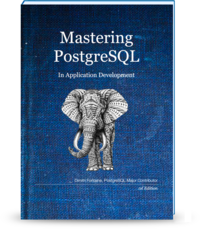Today is the day my book Mastering PostgreSQL in Application Development launches! I’m all excited that everybody interested is now able to actually read my book!
Mastering PostgreSQL in Application Development targets application developers who want to learn SQL properly, and actually master this programming language. Most developers don’t think of SQL as a programming language, mainly because they don’t have full control of the execution plan of their queries.

Buy it online!
When using SQL, you don’t get to write how to fetch the data you are interested in, your job is to describe the data set you need in the simplest possible way. Sometimes this is pretty easy: I want all the information we have in the table drivers about the driver whom driverid is 1 translates easily to
select driverid, driverref, number, code,
forename, surname, dob, nationality, url
from drivers
where driverid = 1;
In this case we get the following result:
─[ RECORD 1 ]────────────────────────────────────────────
driverid │ 1
driverref │ hamilton
number │ 44
code │ HAM
forename │ Lewis
surname │ Hamilton
dob │ 1985-01-07
nationality │ British
url │ http://en.wikipedia.org/wiki/Lewis_Hamilton
In some other cases, describing the data set we are interested in is more complex. If we want the top three drivers in terms of races won, by decade, this is more work. We still need to describe the result set. PostgreSQL has the job of coming up with the best solution possible to actually fetch the data.
The best plan to fetch the data depends on the size of every table involved, and also depends on the data itself: if some data in your query restriction clauses is known to be rare in the dataset, then chances are we should use an index to fetch it… but if it’s pretty common, an index will only slow us down.
The top-three per decade query looks like the following:
with decades as
(
select extract('year' from date_trunc('decade', date)) as decade
from races
group by decade
)
select decade,
rank() over(partition by decade
order by wins desc)
as rank,
forename, surname, wins
from decades
left join lateral
(
select code, forename, surname, count(*) as wins
from drivers
join results
on results.driverid = drivers.driverid
and results.position = 1
join races using(raceid)
where extract('year' from date_trunc('decade', races.date))
= decades.decade
group by decades.decade, drivers.driverid
order by wins desc
limit 3
)
as winners on true
order by decade asc, wins desc;
How to implement a top-N query in SQL is explained in details in Mastering PostgreSQL in Application Development, and you will find this very query and its result set too!
Once you’ve read the book and practiced enough, then writing such a query is going to be no sweat for you. Just think of how many lines of application code (Python, PHP, Java, Go, or something else) you would have to write in order to obtain the same result? How much data would you have to fetch over the network from the database server? This query looks complex. The code you would have to write when you don’t know how to write this query would be even more complex, and I bet, much less efficient.
Finally, here’s the Table of Contents of Mastering PostgreSQL in Application Development:
- Preface
- Introduction
- Some of the Code is Written in SQL
- A First Use Case
- Software Architecture
- Getting Ready to read this Book
- Writing Sql Queries
- Business Logic
- A Small Application
- The SQL REPL — An Interactive Setup
- SQL is Code
- Indexing Strategy
- An Interview with Yohann Gabory
- SQL Toolbox
- Get Some Data
- Structured Query Language
- Queries, DML, DDL, TCL, DCL
- Select, From, Where
- Order By, Limit, No Offset
- Group By, Having, With, Union All
- Understanding Nulls
- Understanding Window Functions
- Understanding Relations and Joins
- An Interview with Markus Winand
- Data Types
- Serialization and Deserialization
- Some Relational Theory
- PostgreSQL Data Types
- Denormalized Data Types
- PostgreSQL Extensions
- An interview with Grégoire Hubert
- Data Modeling
- Object Relational Mapping
- Tooling for Database Modeling
- Normalization
- Practical Use Case: Geonames
- Modelization Anti-Patterns
- Denormalization
- Not Only SQL
- An interview with Álvaro Hernández Tortosa
- Data Manipulation and Concurrency Control
- Another Small Application
- Insert, Update, Delete
- Isolation and Locking
- Computing and Caching in SQL
- Triggers
- Listen and Notify
- Batch Update, MoMA Collection
- An Interview with Kris Jenkins
- Closing Thoughts
Your book companion to learning SQL is now available online at http://masteringpostgresql.com, go buy it! I’ve spent the summer (and then some) working on this title, and I hope you will enjoy reading it as much as I enjoyed writing it!

